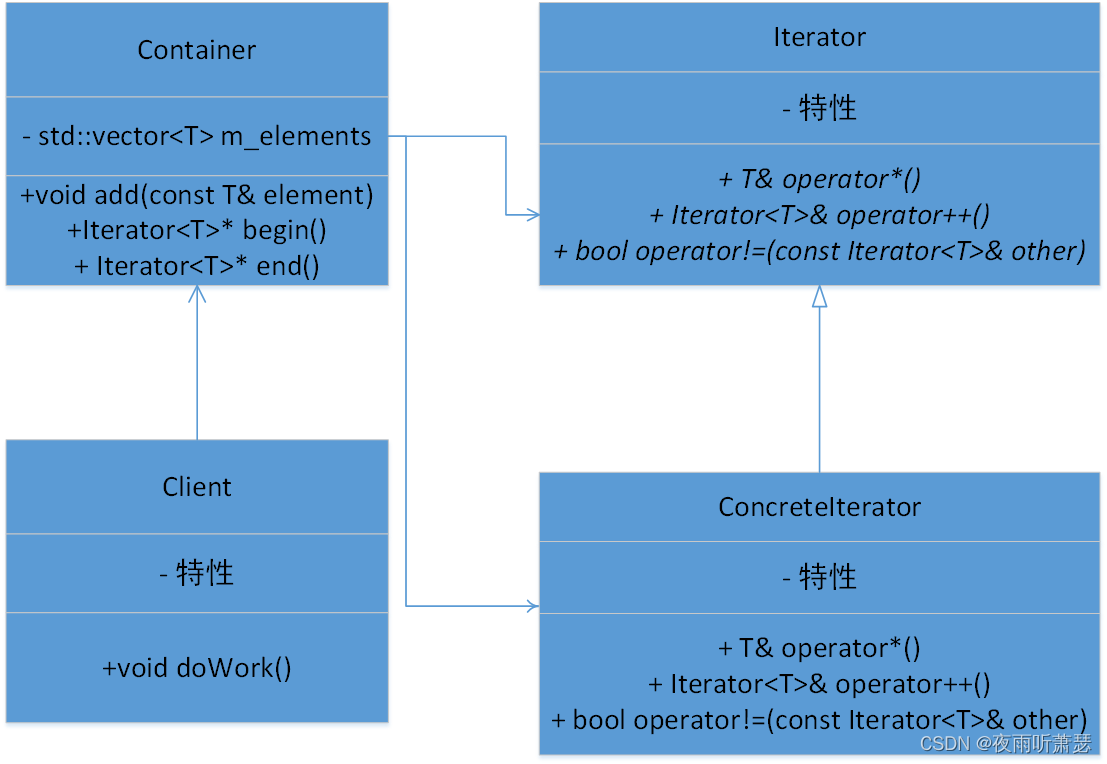1、迭代器模式的提出
在软件开发过程中,操作的集合对象内部结构常常变化,在访问这些对象元素的同时,也要保证对象内部的封装性。迭代器模式提供了一种利用面向对象的遍历方法来遍历对象元素。迭代器模式通过抽象一个迭代器类,不同的对象继承自迭代器类,外部通过统一接口访问元素。
2、需求描述
设计一个能添加数据元素的容器类,并且能够遍历容器数据元素。
3、功能实现
(1)UML图如下:

(2)代码实现如下:
#include <iostream>
#include <vector>// 抽象迭代器接口
template<typename T>
class Iterator {
public:virtual T& operator*() = 0;virtual Iterator<T>& operator++() = 0;virtual bool operator!=(const Iterator<T>& other) const = 0;virtual ~Iterator(){};
};// 具体迭代器类
template<typename T>
class ConcreteIterator : public Iterator<T> {
public:ConcreteIterator(T* ptr) : m_ptr(ptr) {}T& operator*() override {return *m_ptr;}Iterator<T>& operator++() override {++m_ptr;return *this;}bool operator!=(const Iterator<T>& other) const override {const ConcreteIterator* concreteOther = dynamic_cast<const ConcreteIterator*>(&other);return m_ptr != concreteOther->m_ptr;}private:T* m_ptr;
};// 具体容器类
template<typename T>
class Container {
public:void add(const T& element) {m_elements.push_back(element);}Iterator<T>* begin() {return new ConcreteIterator<T>(&m_elements[0]);}Iterator<T>* end() {return new ConcreteIterator<T>(&m_elements[m_elements.size()]);}
private:std::vector<T> m_elements;
};class Client
{
public:void doWork(){Container<float> container;container.add(1.0);container.add(2.0);container.add(3.2);Iterator<float>* itBegin = container.begin();Iterator<float>* itEnd = container.end();while (*itBegin != *itEnd) {std::cout << **itBegin << "\n";++(*itBegin);}delete itBegin;delete itEnd;itBegin = nullptr;itEnd = nullptr;}
};int main() {Client obj;obj.doWork();return 0;
}
程序运行结果如下:

根据容器下标实现的迭代器模式方法也可参考:设计模式-迭代器模式 C++实现_c++ 迭代器模式_MachineChen的博客-CSDN博客
4、面向对象实现迭代器分析
面向对象实现的迭代器模式是在程序运行时,通过虚函数去操作对象元素;相比于C++中的泛型编程实现迭代器的运行性能较低(泛型编程是在编译时已确定访问的元素),所以建议使用泛型编程实现迭代器。
5、泛型编程实现迭代器
#include <iostream>
#include <vector>template<typename T>
class Iterator {
public:Iterator(T* ptr) : m_ptr(ptr) {}// 解引用操作符T& operator*() {return *m_ptr;}// 前缀自增操作符Iterator& operator++() {++m_ptr;return *this;}// 后缀自增操作符Iterator operator++(int) {Iterator iterator = *this;++m_ptr;return iterator;}// 比较操作符bool operator!=(const Iterator& other) const {return m_ptr != other.m_ptr;}private:T* m_ptr;
};template<typename T>
class Container {
public:void add(const T& element) {m_elements.push_back(element);}Iterator<T> begin() {return Iterator<T>(&m_elements[0]);}Iterator<T> end() {return Iterator<T>(&m_elements[m_elements.size()]);}private:std::vector<T> m_elements;
};class Client
{
public:void doWork(){Container<float> container;container.add(1.0);container.add(2.0);container.add(3.2);for (Iterator<float> it = container.begin(); it != container.end(); ++it) {std::cout << *it << "\n";}}
};int main() {Client obj;obj.doWork();return 0;
}
程序运行结果如下:










)


的预览)


)



触摸屏 Bringup 流程 及 源码分析)